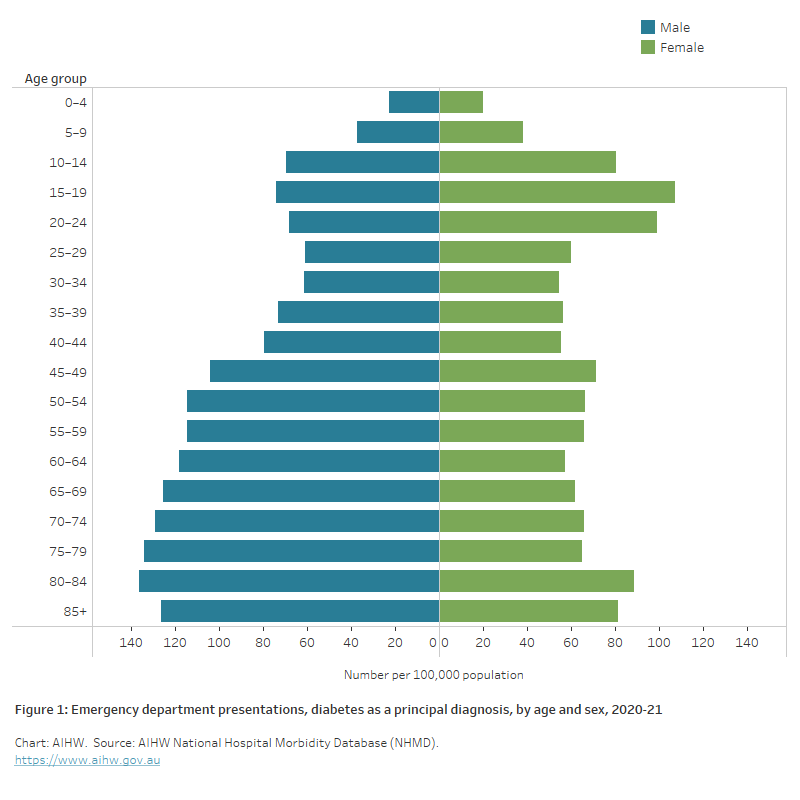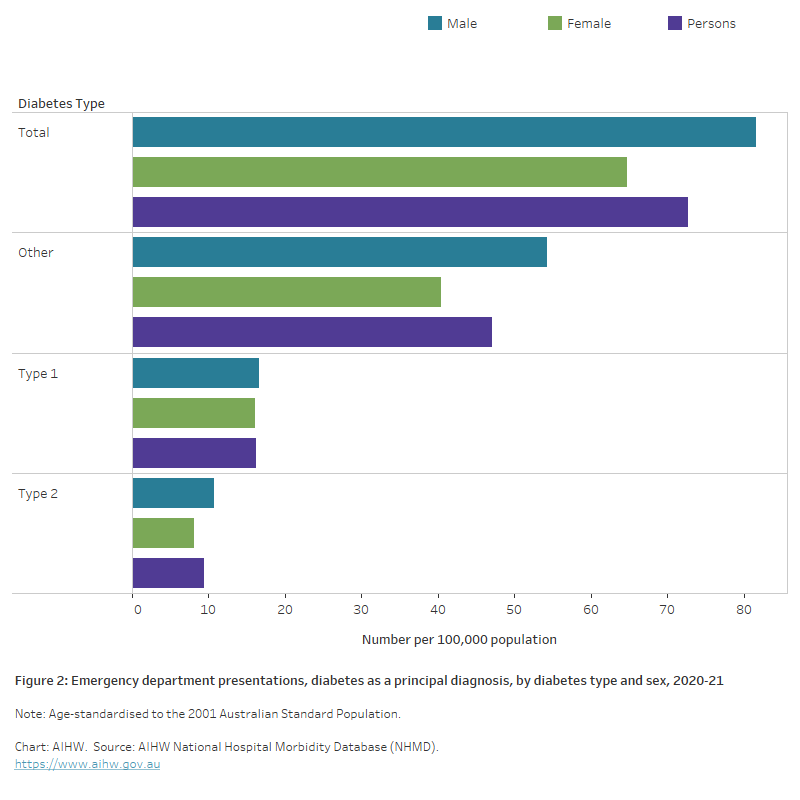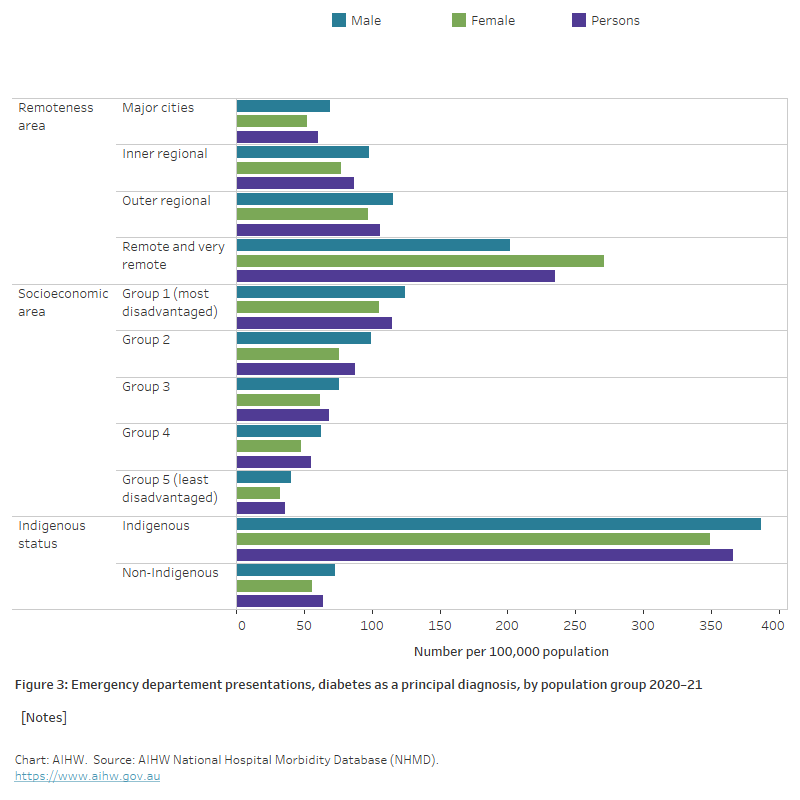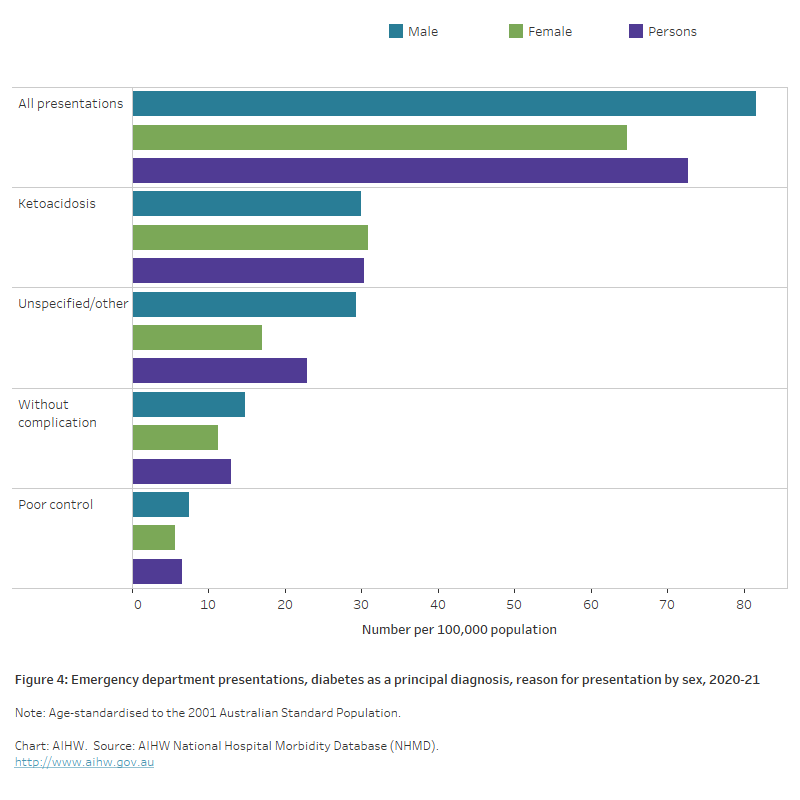Emergency department presentations
Page highlights:
- In 2020–21, there were 19,100 emergency department presentations with a principal diagnosis of diabetes with males being 1.3 times as likely to present as females.
- The rate of diabetes-related emergency department presentations was highest in the 15–19 age group for females and the 80–84 age group for males.
- Almost two-thirds (65%) of emergency department presentations with a principal diagnosis of diabetes were for 'other/unknown diabetes'; 21% were for type 1 diabetes and about 13% were for type 2 diabetes.
- Ketoacidosis was recorded as the reason for presentation in about 40% of all emergency department presentations with a principal diagnosis of diabetes.
- Of all diabetes-related emergency department presentations in 2020–21, 38% were categorised as ‘emergency’ and 39% as ‘urgent’.
- More than three-quarters of patients (76%) presenting to the emergency department with a principal diagnosis of diabetes in 2020–21 were subsequently admitted to hospital; 70% were admitted to the same hospital and 6% were referred to another hospital for admission.
Variation by age and sex
In 2020–21:
- there were 19,100 emergency department (ED) presentations with a principal diagnosis of diabetes (type 1 diabetes, type 2 diabetes or other diabetes)
- after adjusting for age, the overall rate of presentation for males was 1.3 times as high as the female rate
- the rate of diabetes-related ED presentations for females was highest in the 15–19 age group and for males it was highest in the 80–84 age group. Between the ages of 5 and 24, females had a higher rate of presentation but in all other age groups, the rate for males was higher (Figure 1).
Figure 1: Emergency department presentations with a principal diagnosis of diabetes, by age and sex, 2020–21
The chart shows the number of emergency department presentations with a principal diagnosis of diabetes per 100,000 population, by age group and sex in 2020–21. Between the ages of 5 and 24, females had a higher rate of presentation but in all other age groups, the rate for males was higher.

Diabetes types
In 2020–21:
- There were 12,500 ED presentations with a principal diagnosis of ‘other/unknown diabetes’, accounting for almost two thirds (65%) of diabetes-related ED presentations.
- Around one-fifth (21%) of diabetes-related ED presentations had a principal diagnosis of type 1 diabetes (4,000 presentations) and about 13% had a principal diagnosis of type 2 diabetes (2,600 presentations).
After adjusting for age differences in the populations:
- Males were 1.4 times as likely to present to the ED with a principal diagnosis of type 2 diabetes when compared to females.
- Males were 1.1 times as likely to present to the ED with a principal diagnosis of type 1 diabetes when compared to females (Figure 2).
Figure 2: Emergency department presentations with a principal diagnosis of diabetes, by diabetes type and sex, 2020–21
The chart shows the number of emergency department presentations with a principal diagnosis of diabetes per 100,000 population by sex and diabetes type in 2020–21. Presentations were similar by sex for type 1 diabetes and 1.4 times higher among males than females for both other diabetes and type 2 diabetes.

Variation between population groups
In 2020–21, after controlling for age:
- Aboriginal and Torres Strait Islander people presented to the ED with a principal diagnosis of diabetes at 5.7 times the rate of non-Indigenous people
- rates of ED presentation increased with increasing levels of socioeconomic disadvantage. People in the lowest socioeconomic area presented to the ED at 3.2 times the rate of people in the highest socioeconomic area
- presentation rates also increased with increasing remoteness. In Remote and very remote areas, the rate was 3.9 times as high when compared to Major cities (Figure 3).
Figure 3: Emergency department presentations with a principal diagnosis of diabetes, by population group and sex, 2020–21
The chart shows the number of emergency department presentations with a principal diagnosis of diabetes per 100,000 population by selected population group and sex in 2020–21. Presentation rates increased both with increasing levels of socioeconomic disadvantage and remoteness while rates among Indigenous Australians were almost 6 times higher than non-Indigenous Australians.

Reasons for presentation
In 2020–21:
- There were 7,500 ED presentations with a principal diagnosis of diabetes with ketoacidosis, accounting for about 40% of all diabetes related ED presentations. After adjusting for age, males and females presented to the ED with ketoacidosis at a similar rate.
- Just over one-third (34%) of ED presentations had a principal diagnosis of diabetes with an unspecified complication. Males were 1.7 times as likely to present to the ED with this principal diagnosis compared to females, after adjusting for age.
- 9.1% of ED presentations had a principal diagnosis of diabetes with poor blood gluocose control. Males were 1.3 times as likely to present to the ED with this principal diagnosis compared to females after adjusting for age.
- 18% of ED presentations had a principal diagnosis of diabetes without complication. Males were 1.3 times as likely to present to the ED with this principal diagnosis compared to females after adjusting for age (Figure 4).
Figure 4: Emergency department presentations with a principal diagnosis of diabetes, by reason for presentation and sex, 2020–21
The chart shows the number of emergency department presentations with a principal diagnosis of diabetes per 100,000 population by reason for presentation and sex in 2020–21. Ketoacidosis was the main reason for presentation among both males and females while Poor (glucose) control was the least provided reason (30 and 7 per 100,000 population, respectively).

Triage category
Triage category is used to indicate the level of urgency of a patient’s need for care. Of all diabetes-related ED presentations in 2020–21:
- 409 (2.1%) were triaged as ‘resuscitation’ indicating a need for immediate care.
- 7,300 (38%) were categorised as ‘emergency’ (within 10 minutes).
- 7,500 (39%) as ‘urgent’ (within 30 minutes).
- 3,300 (17%) as ‘semi-urgent’ (within 60 minutes).
- 586 (3.1%) as ‘non-urgent’ (within 120 minutes).
End status
Around 70% of patients presenting to the ED with a principal diagnosis of diabetes in 2020–21 were subsequently admitted to the same hospital, with an additional 6% being referred to another hospital for admission. Almost a quarter (23%) departed without being admitted or referred to another hospital.


